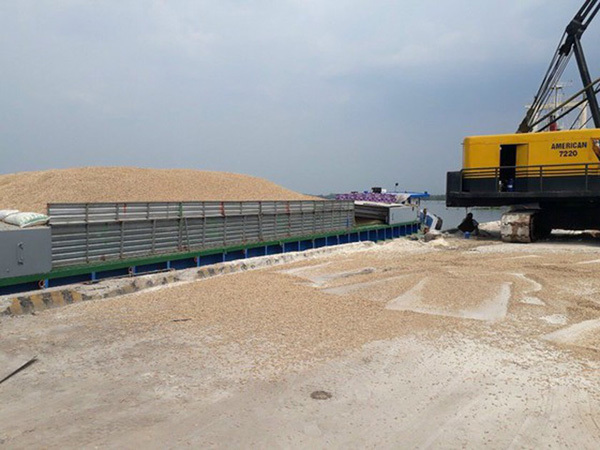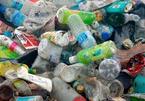Recycled wastes not only contribute to reducing input materials but also limiting output gas emissions.
 |
| Collecting rice husks for the production of rice husk biochar at Mai Anh Dong Thap Company. Photo: SGGP |
Many practical benefits
If wastes, by-products, and defective products during the production process are not handled scientifically and thoroughly, they will cause environmental pollution. To solve this problem, currently, many enterprises have been promoting the reuse and recycling of defective products and by-products into useful products.
For instance, HCMC-based Nestlé Vietnam is implementing a model of developing biomass energy from coffee grounds after the coffee production process. Accordingly, the coffee grounds extracted after processing will be used as biomass energy for the boiler.
This action will contribute to reducing carbon dioxide emissions which cause environmental pollution. After a period of use, it is estimated that biomass energy has helped the company reduce gas emissions by 22,600 tons of carbon dioxide per year, and thereby also helped to replace 73 percent of raw materials each year that the company used to use as fuel.
The waste of coffee grounds after being used for the boiler is non-hazardous. After being internally treated, it can also be used to produce fertilizer. Besides, used Nestlé’s milk cartons are also recycled into ecological roofing sheets.
Developing towards this trend, La Vie Co., Ltd. in Long An Province is also promoting the model of "Zero Waste Disposal". Here, waste is sorted at the source. Wastes that can be processed into useful materials for production then will be transported to the recyclers.
The rest is treated by heat recovery and zero-emission technology. Heat energy is recovered to serve the production activities of the company. All the ash is used for cement production. The gas is treated following the prescribed standards. This process has created a circular economy, helping waste to be fully utilized, instead of ending up in landfills or being discharged into the environment.
Earlier, La Vie used to cooperate with a third party to produce bricks from wastes. Currently, this project is converted to utilize ash after heat recovery technology to produce cement. The application of circular economic models with the highest standards in waste treatment contributes to supporting La Vie to achieve the goals of sustainable development and environmental protection.
Ms. Le Thi Tuyet Mai, Director of Mai Anh Dong Thap Company in Dong Thap Province, said Dong Thap is one of the major rice granaries of the country. Therefore, the source of rice husks collected from rice milling is fairly plentiful and stable. Grasping the development trend of the market and moving towards a green revolution for the economy, her company has chosen rice husks as the main source of raw materials for all of its products.
From the collected rice husks, with advanced technology, this unit has produced products for both agriculture and industry. Typically, rice husk biochar is produced by pyrolysis of biomass in the absence of oxygen. Rice husks produce biochar with a biomass carbon ratio of 35-40 percent.
Rice husk biochar is mixed with raw materials to produce safe bio-organic fertilizers, which helps to improve the soil. Moreover, rice husks are also used to produce environmentally friendly biomass, such as rice husk pellets, chopped rice husk briquettes, and silica.
Inevitable development trend
The promotion of recycling and reuse of wastes and by-products after production has brought many benefits to enterprises themselves and the environment. For enterprises, it will help reduce costs and increase the competitiveness of products. For the environment, it will also reduce a large amount of wastes from production activities.
According to many experts, this is an inevitable development trend in the context that Vietnam is a country with deep integration into the global economy. Most of the free trade agreements that Vietnam has signed have regulations and agreements on sustainable development, environmental protection, climate change response, and waste and emission standards.
Therefore, the fact that enterprises increase recycling and reusing wastes will be an important factor for Vietnam to meet the environmental protection requirements in these agreements. This is also a premise to urge Vietnam to accelerate its transition to a circular economic model and protect the environment.
Associate Professor-Dr. Nguyen Hong Quan, Director of the Institute of Circular Economy Development in Vietnam under the Vietnam National University Ho Chi Minh City, added that in Vietnam, so far, economic activities have been mainly based on a traditional approach that does not pay much attention to the recycling and reuse of wastes. This is also one of the basic causes leading to a shortage of natural resources and serious environmental pollution.
By increasing recycling and reusing wastes, Vietnam is heading to a circular economic model (green economy) - an efficient and environmentally friendly economic model – in which, the output wastes of one industry can be the input materials of another. The circular economic model brings a part or all of the wastes to the old production cycle to restructure and reuse them. Thus, it helps to reduce raw material consumption and recover wastes.
For enterprises, the circular economy contributes to reducing the risk of scarcity of natural resources, creating the driving force for investing and innovating technology, reducing production costs, and increasing the value of the supply chain.
SGGP

Local packaging manufacturers go green
Using environmentally friendly and recycled packaging has become a worldwide trend, forcing packaging manufacturers to adapt.

Vietnamese businesses urged to join circular economy
Vietnamese businesses cannot stand outside the circular economy, especially in the context of global economic integration with commitments on ecological and environmental safety standards through free trade agreements.